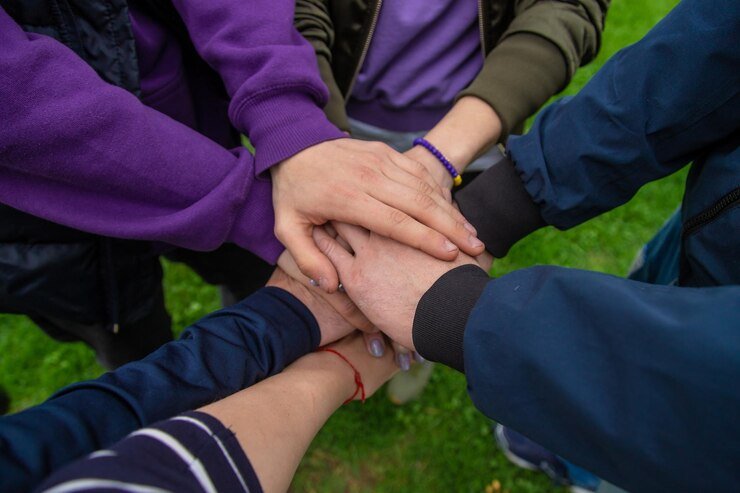The “Wave of Happy” is a growing movement designed to spread positivity and joy. Rooted in simple principles, it aims to uplift individuals and communities alike. By focusing on emotional well-being and shared experiences, the Wave of Happy offers practical benefits for both mental health and everyday life. Whether through personal growth or community impact, this concept is changing lives. As more people join, its influence continues to expand, offering new ways to connect and spread happiness. Let’s explore how this unique approach is making a difference in today’s world.
Table of Contents
What is Wave of Happy?
The “Wave of Happy” is a concept rooted in the simple idea of spreading joy through everyday actions and experiences. At its core, it focuses on enhancing happiness, both on an individual level and within broader communities. This movement is built around positivity, encouraging people to uplift themselves and those around them by embracing a mindset of shared happiness.
The origins of Wave of Happy trace back to times when collective emotions, particularly joy and happiness, became crucial in supporting people through challenges. This movement began as a grassroots initiative, gaining momentum as more individuals connected over the shared goal of improving emotional well-being. Its influence grew rapidly, both online and offline, as people found strength in coming together to foster positivity.
The philosophy behind Wave of Happy emphasizes that happiness is not an isolated experience but something that can spread through interactions and social connections. Through social media, gatherings, and personal connections, this idea has continued to evolve, adapting to modern life while staying true to its purpose of uplifting others.

Understanding its core elements helps to clarify why it resonates so widely. Wave of Happy promotes kindness, gratitude, mindfulness, and emotional intelligence. These key aspects form the foundation of the movement, encouraging people to shift their focus from stress or negativity to moments of joy and appreciation. The goal is to build a ripple effect, where positive actions and attitudes create lasting impacts on individuals and communities.
Wave of Happy’s success also lies in its ability to adapt to various environments. Whether shared through personal stories, social platforms, or community activities, it offers a flexible framework for people to engage with and spread happiness in ways that feel natural to them.
The Science and Psychology Behind Happiness
Happiness is more than just a feeling; it is influenced by a complex interplay of psychological, emotional, and environmental factors. Understanding these elements can provide insight into why movements like the “Wave of Happy” are effective in promoting well-being.
Emotional well-being is closely tied to how people perceive and process their experiences. Positive emotions, such as joy, gratitude, and contentment, not only improve mental health but also contribute to better physical health. Studies show that individuals who consistently experience positive emotions have lower stress levels, better immune responses, and a higher sense of life satisfaction. The brain, through its neurochemical responses, rewards positive behaviors, reinforcing habits that enhance happiness.
Mindfulness and gratitude are two practices that have been widely associated with improving happiness. Mindfulness allows individuals to focus on the present, reducing anxiety about the future or regrets about the past. It encourages awareness and acceptance of one’s thoughts and emotions without judgment. Gratitude, on the other hand, shifts attention to what is going well in life. Regularly acknowledging what one is thankful for can create a lasting sense of fulfillment and joy.
Emotional intelligence also plays a significant role. This refers to the ability to recognize, understand, and manage emotions in oneself and others. People with high emotional intelligence tend to have better relationships, increased empathy, and stronger social connections. These connections are essential, as happiness often grows through interactions with others, making positive relationships a key component of well-being.
Environmental factors are equally important in shaping happiness. Surroundings, including both physical spaces and social environments, can either support or hinder emotional health. Natural light, greenery, and pleasant spaces are known to boost mood, while social environments filled with supportive and positive individuals encourage feelings of belonging and happiness.
Happiness is also linked to having a sense of purpose and meaning. Engaging in activities that align with personal values or contribute to something larger than oneself can generate a deep sense of satisfaction. This sense of purpose is often what drives people to participate in movements like Wave of Happy, where collective joy and shared goals create meaningful experiences.
By combining emotional awareness, mindfulness, gratitude, and supportive environments, individuals can significantly improve their overall happiness. The “Wave of Happy” taps into these principles, fostering a space where people can thrive emotionally, mentally, and socially.
How Wave of Happy Works
The Wave of Happy operates on a simple yet impactful model, focused on spreading positivity through shared experiences, digital interactions, and community engagement. At its core, the movement promotes happiness by encouraging people to take small, meaningful actions that lead to emotional well-being. The combination of social connections and practical tools makes it accessible for individuals to engage and benefit from the concept.
Key Functionalities and Unique Aspects
One of the most distinctive features of Wave of Happy is its emphasis on inclusivity and simplicity. It offers various ways for people to participate, whether through personal practice or community involvement. The idea is that everyone, regardless of background or situation, can contribute to and benefit from the movement.
The platform behind Wave of Happy allows users to access resources that help them cultivate happiness. These include tips on mindfulness, gratitude practices, and emotional intelligence, as well as opportunities to share personal stories or connect with others in the community. Social media plays a significant role in this, enabling the spread of positive messages and creating a ripple effect that extends beyond immediate circles.
User Interface and Experience
From a digital perspective, the interface designed for participants is intentionally simple and engaging. The user experience centers around ease of access, ensuring that anyone can quickly get involved without needing technical expertise. Whether it’s signing up for events, reading inspirational content, or joining group discussions, the platform is user-friendly, with an intuitive layout that emphasizes positivity and connection.
Community-building tools, such as discussion forums, virtual meetups, and activity trackers, help users stay engaged and motivated. These features not only allow individuals to track their personal progress but also encourage collective participation. Whether someone is sharing an uplifting experience or contributing ideas to a group activity, the focus remains on building a supportive and joyful community.
Practical Steps for Participation
Wave of Happy encourages users to engage through small, manageable actions that fit seamlessly into daily life. This might include simple practices like expressing gratitude, offering support to someone in need, or participating in group activities. Regular challenges and events provide additional motivation for participants, helping them to stay connected to the movement while reinforcing positive habits.
In summary, Wave of Happy operates by connecting people with resources, tools, and each other, making it easy to promote and experience happiness on both an individual and collective level. The focus on positive actions, shared experiences, and a supportive digital environment ensures its continued growth and success.
Personal and Community Impact
The Wave of Happy extends beyond individual benefits, positively affecting both personal well-being and entire communities. Its approach to happiness is rooted in the belief that small actions can lead to significant changes, creating a ripple effect that enhances the lives of those involved and their surrounding environments.

Emotional and Mental Health Improvements
On a personal level, the Wave of Happy helps individuals foster emotional resilience and mental wellness. By promoting practices like mindfulness, gratitude, and emotional intelligence, participants develop healthier ways to manage stress, anxiety, and other challenges. Engaging in activities that spread positivity helps to improve mood and overall mental health, contributing to a greater sense of balance and fulfillment in life.
These positive habits gradually build up emotional strength, making it easier for individuals to cope with life’s uncertainties. Regular participation in uplifting activities, whether solo or in a group, encourages feelings of joy and satisfaction, replacing negative thought patterns with healthier, more productive ones. As a result, individuals experience greater emotional stability, improved mental clarity, and a more positive outlook on life.
The Ripple Effect: From Individuals to Communities
The impact of Wave of Happy doesn’t stop with personal well-being. As more individuals engage with the movement, the effects spread into their social circles, influencing families, friends, and even larger communities. When people regularly practice kindness, gratitude, and mindfulness, these actions naturally ripple outward, creating an environment where positivity and support become the norm.
Communities involved in Wave of Happy initiatives often report a stronger sense of togetherness. Group activities, whether virtual or in-person, foster connections between individuals who might not otherwise have met, bringing people closer through shared experiences. This increased sense of belonging reduces feelings of isolation and helps create networks of mutual support, which are critical in times of crisis or stress.
Wider Social Impact
On a broader scale, the Wave of Happy can contribute to community-wide improvements in emotional health and social cohesion. As more people embrace the movement’s principles, there is a noticeable shift towards a culture of care and kindness. These changes manifest in various ways, from local initiatives aimed at improving communal spaces to larger efforts that focus on social well-being.
The movement has also led to greater awareness of mental health issues, reducing the stigma around discussing emotional challenges. By normalizing conversations about happiness and well-being, Wave of Happy promotes openness and understanding within communities, making it easier for individuals to seek help when needed.
Overall, Wave of Happy is not just about personal growth; it’s about creating positive, lasting change in the environments where we live and interact. This collective impact continues to grow as more people join the movement, contributing to a culture of joy and shared well-being that benefits all.
Real-Life Examples and Testimonials
Real-life examples and personal stories bring the essence of the “Wave of Happy” movement to life. These experiences not only highlight the positive outcomes but also show the diverse ways individuals and communities have embraced the idea of spreading joy and positivity.
Personal Stories
Many participants share stories of how the Wave of Happy has made a meaningful difference in their daily lives. Some individuals who have faced challenges, such as anxiety, depression, or stressful life situations, have found solace in the movement’s focus on gratitude and mindfulness. By engaging in small, positive actions regularly, they have noticed significant improvements in their mental health and overall well-being. Simple practices like taking time to appreciate the good things in life or connecting with others in uplifting ways have proven effective in building emotional resilience.
For others, the sense of community and connection that Wave of Happy fosters has been a major benefit. People from different backgrounds come together with the common goal of spreading positivity. These shared experiences often lead to lasting friendships and support networks, reinforcing the idea that happiness grows when shared with others.
Case Studies
Several case studies further illustrate the impact of Wave of Happy on both individuals and communities. In one example, a small town organized a series of local events based on the movement’s principles. Activities included mindfulness workshops, community gratitude days, and collective acts of kindness. The outcome was a noticeable improvement in the emotional well-being of participants, with many reporting a stronger sense of belonging and purpose within their community.
In another case, a group of coworkers introduced Wave of Happy practices into their daily routines, creating a more positive work environment. By starting meetings with a focus on gratitude or sharing personal achievements, team morale increased, and overall productivity improved. The sense of shared purpose and positivity contributed to stronger collaboration and less workplace stress.
Success Stories
Success stories from individuals and groups involved in the Wave of Happy movement demonstrate its broad appeal and versatility. From students incorporating happiness practices into their studies to retirees finding new meaning in shared community activities, the movement has touched lives across generations and regions.
For example, one participant shared how Wave of Happy transformed their approach to relationships. By focusing on positive communication and regularly expressing gratitude, they noticed a significant improvement in their personal interactions. Others have shared similar experiences, where adopting the movement’s principles has strengthened family bonds, friendships, and even professional relationships.
Testimonials from Participants
Many participants express that joining Wave of Happy has introduced them to a more joyful way of living. They often describe feeling more connected, optimistic, and emotionally grounded. Testimonials frequently highlight how small, consistent acts of positivity can lead to profound changes in outlook and happiness levels.
One common theme across testimonials is the simplicity of the movement. People appreciate how easy it is to integrate these practices into their daily routines without requiring significant lifestyle changes. This accessibility allows more people to engage and benefit from the movement, regardless of their circumstances.
Real-life examples and testimonials provide a genuine insight into the power of the Wave of Happy. They show that no matter the situation, anyone can experience the benefits of cultivating positivity and sharing joy with others.
Comparison with Other Programs
The Wave of Happy stands out among various happiness and wellness initiatives due to its unique focus on collective joy, simplicity of engagement, and emphasis on small, meaningful actions. However, to better understand its position in the broader landscape of similar movements, it is helpful to compare it with other programs that promote well-being, mindfulness, and emotional health.
Key Differentiators
One of the key elements that separates the Wave of Happy from other programs is its strong emphasis on community-driven positivity. While many wellness initiatives focus on individual growth and self-improvement, the Wave of Happy highlights the importance of shared experiences and the positive effects of collective happiness. It fosters not just personal well-being but also enhances relationships and social connections, helping individuals feel more connected and supported by those around them.

Additionally, the Wave of Happy is known for its ease of adoption. Other programs may require structured courses, in-depth training, or long-term commitments to see tangible results. In contrast, the Wave of Happy allows people to engage in small, everyday practices that can be integrated naturally into daily life. This accessibility is a major draw for those who may feel overwhelmed by more formal wellness routines.
Another distinctive factor is the movement’s use of digital platforms to spread joy and positivity. While other wellness initiatives may focus on in-person interactions or offer self-guided courses, the Wave of Happy leverages social media and digital tools to create a sense of community across distances. This global reach allows participants to engage with others around the world, creating a widespread ripple effect of joy.
Advantages and Disadvantages
Like any wellness program, the Wave of Happy comes with its own set of strengths and limitations.
Advantages:
- Simplicity: The practices promoted by the Wave of Happy are easy to adopt and require minimal time or resources. Participants can start immediately by incorporating gratitude, mindfulness, and positive actions into their routines.
- Community Impact: By encouraging collective joy, the program has the power to strengthen social ties, creating a sense of belonging and mutual support within communities.
- Accessibility: The digital nature of the movement allows anyone, anywhere, to participate. This flexibility is particularly valuable for those who may not have access to in-person wellness programs.
- Scalability: The model can grow and adapt depending on the size of the community, from small groups to large-scale social movements.
Disadvantages:
- Lack of Structure: While the freedom to engage at one’s own pace is a positive for some, others may prefer a more structured approach. Those seeking clear guidelines or measurable outcomes may feel the Wave of Happy is less formal compared to traditional wellness programs.
- Digital Dependency: While the online aspect is an advantage in terms of global reach, it may also limit deeper, personal interactions that are more easily fostered through in-person engagement. Not all participants may feel as connected through virtual means.
- Sustainability: For some, maintaining the motivation to practice positivity regularly without structured support or consistent reminders can be a challenge. Other programs that provide ongoing coaching or mentorship may offer more sustained results for certain individuals.
Comparison with Similar Programs
In comparison to mindfulness-based programs such as Mindfulness-Based Stress Reduction (MBSR) or emotional intelligence training initiatives, the Wave of Happy focuses less on introspection and more on outward expressions of positivity. While mindfulness programs emphasize deep self-awareness and meditation practices, the Wave of Happy encourages participants to focus on simple, everyday actions that promote joy in both themselves and others.
Similarly, when compared to large-scale global happiness movements like Action for Happiness, the Wave of Happy differentiates itself by placing more importance on digital engagement and social sharing. Action for Happiness also promotes kindness and positive actions but typically relies on structured courses and formal gatherings, whereas Wave of Happy maintains a more flexible, grassroots approach.
The Wave of Happy continues to be a powerful movement due to its emphasis on community joy, simplicity, and global reach, even as it contrasts with other wellness initiatives that may take a more structured or individualized approach.
Conclusion
The Wave of Happy has proven to be a powerful movement for fostering joy and positivity through both individual actions and collective experiences. Its accessible approach allows people to integrate simple, meaningful practices into their daily lives, contributing to their emotional and mental well-being. As the movement continues to grow, it strengthens communities by creating connections based on shared happiness. Whether through personal stories, real-life examples, or comparisons with other programs, it is clear that Wave of Happy offers a unique way to spread positivity and make a lasting impact on both individuals and society.










